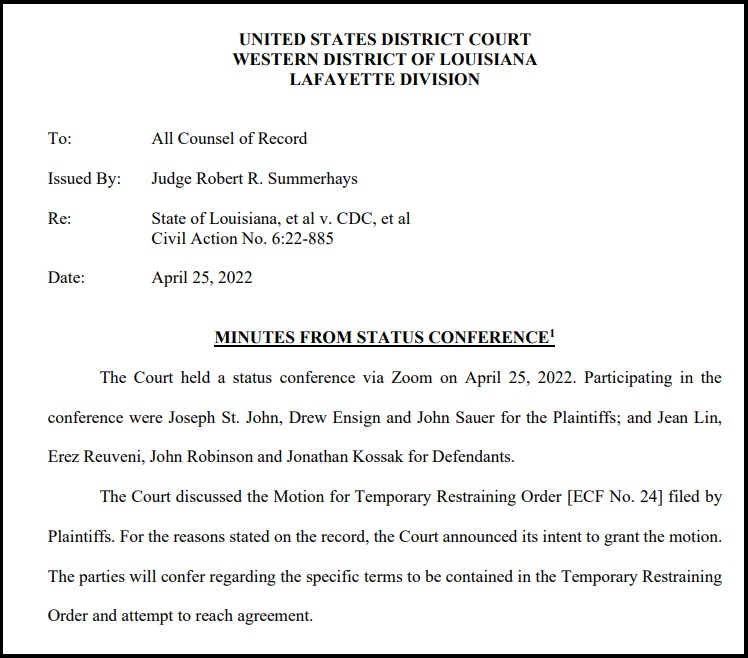Voters appear poised to clobber the party that brought us COVID lockdowns, mask and vaccine mandates, and inflation. Indeed, rising inflation has largely resulted from COVID-related disincentives to work, disrupted supply chains, and blowout spending, along with federal restrictions on oil and gas production. It’s perhaps surprising, therefore, that the Cook Political Report foresees Republican gains in the House of Representatives as being only “in the 15-25 seat range,” while its projections suggest that Democrats have at least a coin flip’s chance of holding the Senate.
In a widely read piece, Cook’s Amy Walter grants that “both sides see the possibility of a Red Tsunami in 2022” and that “every metric we use . . . point[s] to huge gains for the GOP this fall.” Walter nevertheless remains skeptical that a big Republican wave will materialize, in part because “districts are more polarized than ever,” leaving fewer competitive seats on the board. Her skepticism, however, is also rooted in (and perhaps informs) which numbers she chooses to use in her analysis.
“In every midterm election since 2006,” Walter writes, “the party in the White House has seen its share of the two-party House vote (the popular vote for the House) drop by anywhere from 6.5 to 17 points from the previous presidential election.” She then projects the Democrats could see their share of the House vote drop by 6.6 points—essentially matching the low end of the historical range she cites—which she says could result in a net loss of 15 to 25 Democratic House seats.
Walter calculates this prospective 6.6-point shift from Democrats to Republicans by comparing the RealClearPolitics average for the generic congressional ballot, which favored Republicans by about 3.5 points at the time of her writing, with the national House vote in 2020, which the Democrats won by 3.1 points. Interestingly, she chose to compare the current generic congressional ballot with prior election results, rather than comparing the generic congressional ballot at this point in 2022 with the generic congressional ballot at this point in 2020, which would suggest how much things have changed over the past two years. Comparing the generic congressional ballots across the two years shows a prospective swing of 10.9 points between Democrats’ 7.4-point advantage on April 22, 2020 and Republicans’ 3.5-point advantage on April 22, 2022—rather than the 6.6-point swing of which Walter writes.
“So, what would a 6.6 point shift to the right look like?” Walter asks. “At a very crude level, we could say that it would shift the 2020 vote margin in every CD, about 7 points more Republican.”
Oddly, however, she then pulls Joe Biden into the picture, writing, “So, for example, a district that Biden carried 52 percent to 45 percent (+7) would become a jump ball (50-50) in 2022.” She adds, “Or, a better way to think about it is that any district Biden carried by less than 7 points would be in danger of flipping to the GOP.” Walter observes, “there are only 21 districts where Biden’s margin was fewer than seven points,” and “eight of those 21” are already held by Republicans. This would suggest that GOP gains might be on the order of 13 seats (21 minus 8), lower even than Walter’s projected range of 15 to 25.
The shift that would really matter, however, is the shift in the House vote, not the shift in the House vote in relation to the presidential vote.
The Democrats won 31 House races in 2020 by 7 points or less (or by less than 7.5 points, to be more exact). Most of those Democratic-held seats will presumably be quite vulnerable in 2022. If the shift in party support, however, is more like the 10.9-point difference between the current generic congressional ballot and the one from two years ago, that would bring even more Democratic-held seats into play.
In 2020, the Democrats won 41 House races by 10 points or less (or by less than 10.5 points, to be more exact). Extending that range by another three points encompasses another dozen districts where Democratic incumbents are up for reelection. In addition, in another five districts in which Democrats won by an average of just under 15 points (California’s 9th Congressional District, Florida’s 7th and 22nd Congressional District, New York’s 4th Congressional District, and Rhode Island’s 2nd Congressional District), early retirements have put even more seats into play.
On the flip side, although the latest census favored Republicans, it appears this advantage has been negated, and then some, by redistricting. While redistricting seems to have had little effect across most of the country, blatant gerrymandering by Democrats in New York and Illinois will likely cost Republicans about a half-dozen seats in relation to how many they likely would have won under the old map. In those two states combined, redistricting cut the number of GOP-leaning districts by more than half, from 15 to seven. No Republican-led states were as ruthless in targeting Democratic districts. (Florida’s new map—proposed by Governor Ron DeSantis and approved by the Florida legislature—which the mainstream media has roundly criticized while remaining mostly silent about Illinois and New York—would cut the number of Democratic-leaning seats by less than a fifth, from 11 to nine.)
Despite these challenges in the Empire and Prairie states, Republicans appear poised to make big gains in the House. Indeed, putting all of this together, GOP gains in the House could be twice as large as the midpoint of Walter’s projection. While things could change over the next six months (although the cake is probably largely baked), a GOP gain of 30 to 40 House seats appears more likely at this stage of the contest than Walter’s projected GOP gain of 15 to 25 seats.
The Cook Political Report also suggests the Democrats have at least an even-money chance of holding the Senate—a bet that not even most Democratic operatives would take.
With Republicans needing to pick up just one seat to take control of the Senate, Cook currently has five Senate contests rated as “toss-up” races, with three of these being Democratic-held seats. So, if all other races go as expected, Democrats must win three of these five “toss-up” races to retain control, while Republicans must win three to take control. Neither party would seem to have an identifiable edge, according to Cook—except that Republicans must also defend three additional seats that “lean” their way but are nevertheless “competitive,” while Democrats must defend only one such seat. So, if anything, the Democrats appear to have the advantage—according to Cook.
This seems wildly off, and indeed Cook’s own history suggests that it is. Across the past four federal elections (2014, 2016, 2018, and 2020), Cook designated 32 Senate contests as “toss-up” races (in its final projections before the election). Republican Senate candidates posted a win-loss record of 23-9 in those contests, winning a whopping 72 percent of the time.
Beyond these so-called toss-ups, Cook claims Marco Rubio (R-Fla.) is in more danger of losing his Senate seat in 2022 than Michael Bennet (D-Colo.) is of losing his. Cook designates Bennet’s race as a “likely” Democratic win and says that it is “not considered competitive” by Cook at this time, while Rubio’s race is “competitive” and merely involves a “lean” toward the GOP. Again, this seems wildly off, and—again—Cook’s history suggests that it is.
Across the past four federal elections, eight Democrats ran in Senate races thatCook (in its final projections before the election) said were “likely” Democratic wins, and those Democrats won by an average of 9.1 points and a minimum of 0.8 points (Virginian Mark Warner’s sliver of an advantage over Ed Gillespie in 2014). Meanwhile, 11 Republicans ran in Senate races that Cook said merely showed a “lean” toward the GOP, and those Republicans have won by an average of 13.7 points and a minimum of 7.3 points.
In other words, Republicans have been noticeably more dominant in “competitive” races in which they’ve merely enjoyed a “lean”—according to Cook—than Democrats have been in allegedly noncompetitive, “likely”-win races. So, based on Cook’s own history, Rubio is notably safer than Bennet.
Over that same period, seven Republican candidates have run in Senate races that Cook said were “likely” Republican wins. Those Republicans have won by an average of 18.9 points—more than double the Democrats’ 9.1-point margin in such “likely”-win races. Among these seven Republicans, the smallest margin of victory was 10 points.
So, here’s how to decode the Cook Senate projections: If Cook says a race is a toss-up, give the Republican between a two-thirds and three-quarters chance of winning. If Cook says a race is a likely Democratic win or one that leans that party’s way (Democrats’ average margin of victory in races that “lean” Democratic was 8 points over the past four federal elections), expect that the Democrat will probably win pretty easily but recognize that he or she has a dark-horse chance of losing. If Cook says a race leans Republican, consider it pretty much a sure thing for the GOP. And if Cook says a race is a likely Republican win, consider it an outright lock and expect a GOP rout.
Using this handy decoder, Cook’s current projections suggest that—as most people assume—Republicans will likely take over the Senate. Odds are they will win three or four of the five “toss-up” races—those involving Ron Johnson (R-Wis.), Mark Kelly (D-Ariz.), Raphael Warnock (D-Ga.), Catherine Cortez Masto (D-Nev.), and the open (GOP-held) seat in Pennsylvania—while easily winning the races that “lean” their way (Rubio and the open races in Ohio and North Carolina to fill GOP-held seats). That would be enough to give Republicans a Senate majority.
The “lean”-Democrat race involving Maggie Hassan (D-N.H.) is also very much in play and might eventually find itself in Cook’s “toss-up” column (from which Republicans usually emerge victoriously). In addition, Bennet’s seat is a realistic long-shot possibility for the GOP. In all, the chances of the Democrats holding onto the Senate are lower than the chances of the Republicans ending up with at least 53 seats—and hence a Romney- and Murkowski-proof majority.
Party allegiance has shifted considerably over the past half-dozen years, and it’s still shifting. Yesterday’s freedom-loving hippie is today’s authoritarian scold (see: Young, Neil), as this political cartoon nicely depicts. The Wall Street Journal published a news story headlined, “School Mess Drives Parents to GOP,” and a subheadline reading, “Some Democratic voters, frustrated with party’s Covid policies, are backing Republicans.” The Democrats will almost surely pay a hefty price for their coercive mandates in November.
Most establishment pundits, however, still don’t recognize that voters granted Republicans control of the House in 1994 (for the first time in four decades) because they opposed Hillarycare, that voters backed Republicans and gave Democrats a “shellacking” (to use President Obama’s term) in 2010 because of Obamacare, and that voters mutinied against the establishments of both parties in 2016, largely over questions of immigration and trade but also because of general frustration with the disconnected ruling class. Those same establishment pundits aren’t likely to see the next wave coming—or even to recognize it after the fact.









